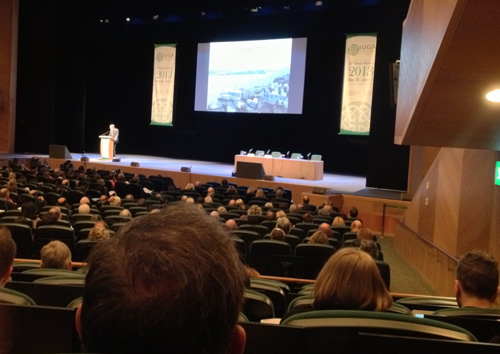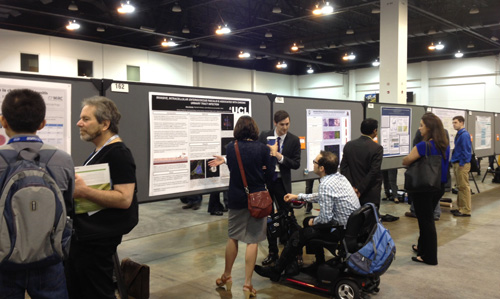For the past few weeks I’ve been traveling the globe at back-to-back conferences – hence the silence here. The conference universe has its own natural laws, and time flows differently as its strict routines overwrite all of your own normal ones.
Instead of thinking about experiments, papers and grants in the familiar environment of your own lab, you are thrust into a throng of many hundreds of people whose scientific interests overlap and diverge in a complex intellectual Venn. Inside the same Venn unit, these people can be friends, or long-standing competitive enemies, or strangers of uncertain provenance who need to be sniffed out and analyzed for their potential to fall into one or the other group in the future. Sometimes, there is a fine line between enemy and friend; you can be on great terms with a scientist but deeply uneasy about telling them anything of substance about your own work, in case they might be given an ill-advised clue. Outside your own particular Venn, passing scientists can be so much white noise, fellow companions on a completely different journey studying topics that have little relevance to your own work.
Instead of experiencing scientific knowledge through the immediacy of test tubes and physical results, or the polished, almost sterile patina of published research on paper, conference-goers are immersed in a grey zone of works in progress, often presented in a manner that makes the results feel more solid than they actually are. It’s very difficult to critique an eight-minute talk or a meter-square piece of paper when you put your preliminary findings up for public scrutiny on the podium or posterboard. You want to advertise how far along your work is, to discourage competitors from trying to beat you to the punchline, but you don’t want to give anything crucial away too soon, either. So the delicate dance plays out a thousand different ways all over the various carpeted, air-conditioned levels of the conference center, in hushed auditoria or over scorched coffees or cheap Merlot – researchers sizing one another up, probing their respective projects, wondering exactly what is being held back or what might be slightly exaggerated for best effect.
I was terribly proud of my research assistant, Harry, for defending himself admirably against a veritable onslaught of curious (and largely friendly) visitors to our poster from various competitor labs at the American Society for Microbiology – we’ve only recently come onto the scene, so it was good to make a favorable impression. Not least because this poster marks a career milestone in my own career: my first poster as the senior author.
I feel like I’ve been away from the lab, and home, for years. Traveling and intense mental exertion (to say nothing of sleep deprivation and jet-lag) can be made sweeter by social episodes at the end of the day – like a spontaneous congregation at this friendly pub in Temple Bar, Dublin on a lingering, nearly-summer evening.
But I am looking forward to flying home tomorrow, at long last, to restart my real life once again.





Oh man, I was so exhausted after just the ASM. I would have died if I’d have to go to another non-UK meeting. But it was so good to see you in Denver, and your lab!
I’ve been going to conferences for 20 years, and I do sometime wonder what they are really for – especially in those disciplines that are so competitive that people don’t dare present work in progress.
I guess the reasons we attend meetings change with time. I remember the excitement of my first meetings as a PhD student and then post-doc, defending a poster or occasionally giving a brief but nerve-shredding platform presentation, but now it’s very different. I find meetings to be a surprisingly good stimulus for new research ideas, sometimes prompted by talks or posters, but often I suspect simply the result of having some time away from the lab to think.
And these days meetings are much more about networking – a chance to catch up with collaborators from around the world, and to talk to industrial or pharma partners. But it was at one meeting in Florida back in 2005 that a chat over a beer led to a project that culminated in a study that led to a paper now in press at a journal much loved by Henry. The story of how this all happened will be the subject of a blog, and may well be of more general interest than the discovery we made.
Congrats on the poster, Jenny. A career milestone indeed.
As for conferences – I’m kind of with Henry on this. I’ve been to my share I suppose, but the only really memorable things are after-hours discussions, and the occasional keynote talk. The onslaught of concurrent sessions, vendor-sponsored lunchtime workshops and panels, and posters… haven’t left much of an impression.
I found the Denver conference really useful, actually. This is a slightly new field for me (or at least a new tangent on an old one) and I met all of our major competitors for the first time (fortunately they were quite friendly) – they gave us some methodological tips and even offered to send us some useful reagents. I also got a good overview of the big picture, just by osmosis. So it was definitely worth it for me. I know what Henry means, though – in the past, in very competitive fields like cancer and apoptosis, I did sometimes wonder what the point was.
Stephen, I can’t wait to read your blog about your big discovery!
Hey, I guess I was being a bit arch. And when I go to conferences I go as a representative of Your Favourite Weekly Professional Science Magazine Beginning With N, so my impressions will be rather different from those of the ‘real’ delegates. But stephenemoss is right – it’s all about the networking.
These days I find myself going less to platform presentations and more to posters. Poster sessions (and parties and receptions) find me wandering around in a Lévy-Flight pattern hoping to bump into something or someone interesting, and making myself available to delegates who want to pitch me a paper (yes, it happens.) Platform presentations seem so often to be by people fulfilling contractual obligations – you know, they’d only get funds to go if they were giving a paper. It’s all too easy to be stuck for 30 minutes in a talk whose title promised much but proved a clunker.
Palaeontology meetings can be really adventurous. Every so often you find yourself in a small huddle and someone will bring out, from an inside pocket, a fossil or snapshot of something really, really weird and show it round to for the opinion of delegates – that’s how I saw the first picture of the first feathered dinosaur to be published. Now, that’s a tale. It was a Chinese delegate to a meeting in NYC, who showed it round to the assembled palaeontologists. Naturally I gave the delegate my contact details (on half a beermat – I am never with proper business cards when I really need ’em) and in due course the paper made it into Your Favourite etc.
Fifteen years later I met the same scientist in Nanjing, almost by chance. He opened his wallet … and pulled out the same torn beermat upon which I’d written my details all those years before.